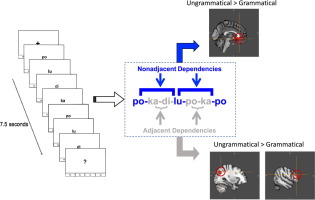当前位置:
X-MOL 学术
›
Neurobiol. Learn. Mem.
›
论文详情
Our official English website, www.x-mol.net, welcomes your
feedback! (Note: you will need to create a separate account there.)
Distinct neural networks for detecting violations of adjacent versus nonadjacent sequential dependencies: An fMRI study.
Neurobiology of Learning and Memory ( IF 2.2 ) Pub Date : 2020-02-01 , DOI: 10.1016/j.nlm.2020.107175 Christopher M Conway 1 , Leyla Eghbalzad 2 , Joanne A Deocampo 2 , Gretchen N L Smith 2 , Sabrina Na 3 , Tricia Z King 3
Neurobiology of Learning and Memory ( IF 2.2 ) Pub Date : 2020-02-01 , DOI: 10.1016/j.nlm.2020.107175 Christopher M Conway 1 , Leyla Eghbalzad 2 , Joanne A Deocampo 2 , Gretchen N L Smith 2 , Sabrina Na 3 , Tricia Z King 3
Affiliation

|
The ability to learn and process sequential dependencies is essential for language acquisition and other cognitive domains. Recent studies suggest that the learning of adjacent (e.g., "A-B") versus nonadjacent (e.g., "A-X-B") dependencies have different cognitive demands, but the neural correlates accompanying such processing are currently underspecified. We developed a sequential learning task in which sequences of printed nonsense syllables containing both adjacent and nonadjacent dependencies were presented. After incidentally learning these grammatical sequences, twenty-one healthy adults (age M = 22.1, 12 females) made familiarity judgments about novel grammatical sequences and ungrammatical sequences containing violations of the adjacent or nonadjacent structure while in a 3T MRI scanner. Violations of adjacent dependencies were associated with increased BOLD activation in both posterior (lateral occipital and angular gyrus) as well as frontal regions (e.g., medial frontal gyrus, inferior frontal gyrus). Initial results indicated no regions showing significant BOLD activations for the violations of nonadjacent dependencies. However, when using a less stringent cluster threshold, exploratory analyses revealed that violations of nonadjacent dependencies were associated with increased activation in subcallosal cortex, paracingulate cortex, and anterior cingulate cortex (ACC). Finally, when directly comparing the adjacent condition to the nonadjacent condition, we found significantly greater levels of activation for the right superior lateral occipital cortex (BA 19) for the adjacent relative to nonadjacent condition. In sum, the detection of violations of adjacent and nonadjacent dependencies appear to involve distinct neural networks, with perceptual brain regions mediating the processing of adjacent but not nonadjacent dependencies. These results are consistent with recent proposals that statistical-sequential learning is not a unified construct but depends on the interaction of multiple neurocognitive mechanisms acting together.
中文翻译:

用于检测违反相邻相依性或不相邻相依性的独特神经网络:一项功能磁共振成像研究。
学习和处理顺序依存关系的能力对于语言习得和其他认知领域至关重要。最近的研究表明,相邻(例如“ AB”)和不相邻(例如“ AXB”)依赖项的学习具有不同的认知要求,但是目前尚不明确伴随这种处理的神经相关性。我们开发了一个顺序学习任务,其中提出了包含相邻和不相邻依存关系的印刷废话音节序列。在偶然地学习了这些语法序列之后,二十一位健康的成年人(M = 22.1,12位女性)在3T MRI扫描仪中对新颖的语法序列和包含违反相邻或不相邻结构的非语法序列进行了熟悉的判断。在后部(枕骨外侧和角状回)以及额叶区域(例如,额中内侧,额下回)中,邻近相依的违反与BOLD激活的增加有关。初步结果表明,没有违反非相邻依赖关系的区域显示出明显的BOLD激活。但是,当使用不太严格的簇阈值时,探索性分析显示,违反不相邻依赖关系的情况与call下皮层,扣带回皮层和扣带回前皮层(ACC)的激活增加有关。最后,当直接比较相邻状态与不相邻状态时,我们发现相对于不相邻状态,右上枕叶外侧皮质(BA 19)的激活水平明显更高。总共,对相邻和非相邻依赖项违规的检测似乎涉及不同的神经网络,感知性大脑区域介导相邻但非相邻依赖项的处理。这些结果与最近的建议一致,即统计顺序学习不是统一的结构,而是取决于多个神经认知机制共同作用的相互作用。
更新日期:2020-02-03
中文翻译:

用于检测违反相邻相依性或不相邻相依性的独特神经网络:一项功能磁共振成像研究。
学习和处理顺序依存关系的能力对于语言习得和其他认知领域至关重要。最近的研究表明,相邻(例如“ AB”)和不相邻(例如“ AXB”)依赖项的学习具有不同的认知要求,但是目前尚不明确伴随这种处理的神经相关性。我们开发了一个顺序学习任务,其中提出了包含相邻和不相邻依存关系的印刷废话音节序列。在偶然地学习了这些语法序列之后,二十一位健康的成年人(M = 22.1,12位女性)在3T MRI扫描仪中对新颖的语法序列和包含违反相邻或不相邻结构的非语法序列进行了熟悉的判断。在后部(枕骨外侧和角状回)以及额叶区域(例如,额中内侧,额下回)中,邻近相依的违反与BOLD激活的增加有关。初步结果表明,没有违反非相邻依赖关系的区域显示出明显的BOLD激活。但是,当使用不太严格的簇阈值时,探索性分析显示,违反不相邻依赖关系的情况与call下皮层,扣带回皮层和扣带回前皮层(ACC)的激活增加有关。最后,当直接比较相邻状态与不相邻状态时,我们发现相对于不相邻状态,右上枕叶外侧皮质(BA 19)的激活水平明显更高。总共,对相邻和非相邻依赖项违规的检测似乎涉及不同的神经网络,感知性大脑区域介导相邻但非相邻依赖项的处理。这些结果与最近的建议一致,即统计顺序学习不是统一的结构,而是取决于多个神经认知机制共同作用的相互作用。











































 京公网安备 11010802027423号
京公网安备 11010802027423号